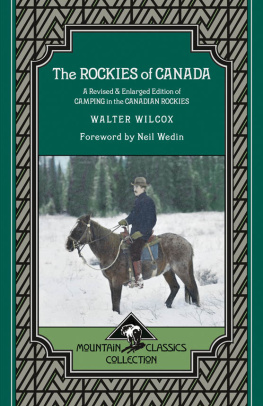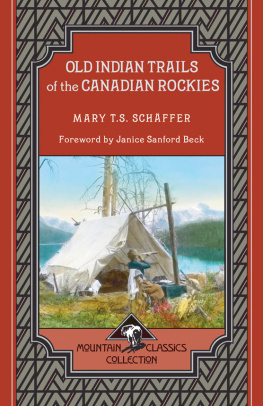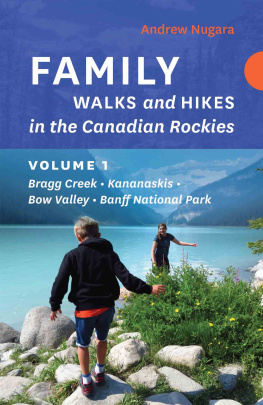Contents
Copyright 2008 Rocky Mountain Books Ltd.
All rights reserved.
Originally published by Rocky Mountain Books in 2008 in paperback with ISBN 978-1-897522-14-1.
This electronic edition was released in 2011.
Electronic monograph in HTML format: 978-1-926855-41-7
Cataloguing data available from Library and Archives Canada
Front cover photo of Walter Wilcox. (Whyte Museum of the Canadian Rockies, NA66469)
Rocky Mountain Books acknowledges the financial support for its publishing program from the Government of Canada through the Canada Book Fund (CBF) , Canada Council for the Arts, and the province of British Columbia through the British Columbia Arts Council and the Book Publishing Tax Credit.

Rocky Mountain Books
www.rmbooks.com
Foreword
There are hundreds of unclimbed mountains within a few miles of the railroad, and it may safely be said that mountaineering in the Canadian Rockies is now making its early history.
Walter Wilcox
It seems arguableand plausiblethat the release of the first edition of Camping in the Canadian Rockies in 1896 played a key role in spurring on the worlds fascination with the Canadian Rocky Mountains. News agents and travel posters all over the world were promoting the splendours of Canada. And on the heels of this incredible advertising blitzfostered mostly by the massive North American railway companiescomes a book that took adventure-hungry readers into a place with mountains so rough and high, the valleys separating them so deep and gloomy, yet withal so beautiful, that the scenery approaches perfection.
A couple of years after the release of the first edition, Walter Wilcox renamed his book The Rockies of Canada . It is likely that heor maybe his metropolitan publisherthought the scope of the book should be broadened beyond the provincially limited notion of camping. Indeed, the book was much more than a collection of hunting and fishing tales. The Rockies of Canada was an unmitigated paean to a unique and truly overwhelming place: the relatively untouched and romantically foreboding Canadian Rockies.
Wilcox made several trips to these mountains through the latter part of the 19th and first years of the 20th century. His book evolved accordingly, with the release of several editions between 1896 and 1909. The present re-edition is of the 1909 version, the final one the author himself presented to his eager readership. One wonders whether Walter Wilcox could ever have imagined the indelible impression he made on an entire region of the world and the way the place ultimately would be experienced by millions of visitors. While he certainly had the prescience to note that Banff, with its fine drives and beautiful scenery, its luxurious hotels and delightful climate, will ever enjoy popularity among tourists, one must wonder if he could ever have envisioned how the worlds appetite for Banff, Lake Louise, and the Canadian Rockies would one day become seemingly insatiable.
Born in Chicago in 1869 and educated at Yale, Walter Dwight Wilcox was, like many of the early explorers of the Canadian Rockies, a well-educated, well-heeled, and earnest adventurer. Thanks fundamentally to the ever-expanding railways, many of his contemporaries had both the means and the desire to head west and see the Great Plains and the Rocky Mountains that comprised the wilds of western Canada.
The Rockies of Canada was, for all intents, the first real guidebook for climbers and explorers of the Alberta and British Columbia peaks. With its handsome oversized format and striking gilt cover, the book became a bestseller not only in the small town of Banff but in all the large, bustling cities of North America. There is no doubt that Wilcoxs book inspired such luminaries as Mary Schffer, A.P. Coleman and James Outram to head to these rugged mountains and eventually make their various contributions. It is also without question that Wilcoxs book played an integral and inspiring role in the work of Hugh Stutfield and Norman Collie and the eventual publication of their seminal volume, Climbs and Explorations in the Canadian Rockies .
But it seems slightly erroneous to call The Rockies of Canada a mere guidebook. In the development of its narrative, it often reads as an exceptionally enthralling piece of creative non-fiction. The book became the fodder of dreams for armchair adventurers all wishing to head west and experience what the travel agentsthe Canadian Pacific Railway Company in particularwere offering. Of course, most of Wilcoxs readers had neither the means nor the inclination to actually make the multi-week trip to the Rockies, but Victorians on both sides of the ocean had an unquenchable thirst for the excitement of mountains, poles, and seas.
The structure of the various editions of the work follows Wilcoxs conception of the opening of the Canadian Rockies to tourism: The history of the mountains may be divided roughly into two periods: first a search for the easiest routes through the wilderness, then an invasion of climbers looking for unconquered difficulties. While the various tour companies and local guides helped ease several of the unpleasant elements of early travel, the invasion of climbers envisioned by Wilcox proved, in the short term at least, to be limited to a relatively few explorers.
The first section of the book takes the reader along as Wilcox discovers the town of Banff and the picturesque areas between the townsite and Lake Louise. He paints a vivid portrait of a rustically beautiful place of azure lakes and lofty peaks. Expansive, yes, but, with a little good-natured grit, accessible to even the most tenderfooted tourist.
As the book develops, however, the reader soon recognizes that Wilcoxs true love is for adventure and exploration beyond the quaint gravel roadways frequented by most of the other early visitors. Its not long before readers find themselves wandering with Wilcox among the deep and gloomy valleys between the dozens of unclimbed peaks of the Rockies. Now, so to speak, the action begins.
Here we find the true heart of The Rockies of Canada . Here is where the book evolves beyond a simple travel narrative, transforming Wilcox from passive observer to formidable and active explorer. The reader joins the adventurer in making camp, wandering trails, and ascending lofty peaks with the likes of Bill Peyto, Jimmy Simpson, and Tom Wilson: literally the Rockies first non-native trailblazers. A book that begins essentially as a vacationers roadmap becomes a chronicle of legendary figures accomplishing legendary feats.
Combine these fascinating exploits with a profound recognition of the fleeting nature of experience, and Wilcox has written a timeless testament. While it is easy to criticize almost any writing from a bygone age by applying todays standards of terminology or attitudes toward, say, indigenous peoples or environmental issues, documents such as these, when taken as a whole, elevate themselves beyond contemporary notions of political correctness. In effect, through words that are in and of his own era, Wilcox affords us an authentic and personal glimpse into a magnificent place that was both on the eve of and in the midst of fundamental change.
Walter Wilcox was one of the most important figures in the early development of tourism and mountaineering in what he called the vast solitude of the Canadian Rockies. His book became a definitive tool for the growing number of people intrigued by the offerings of the Canadian Pacific Railway. While the actual number of copies of The Rockies of Canada published eludes us, there is little question that the work found its way onto the mantels and bookshelves of a legion of adventure-minded people who would eventually find themselves enjoying the Canadian Rocky Mountains.










